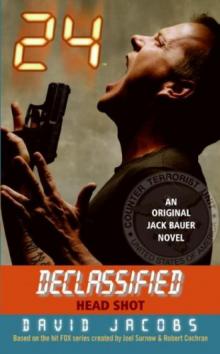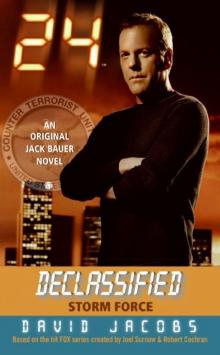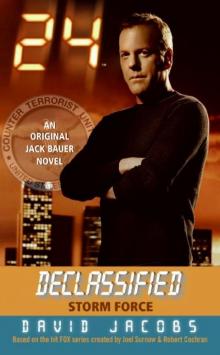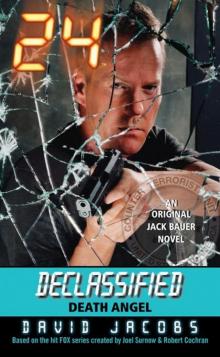- Home
- David S. Jacobs
24 Declassified: Head Shot 2d-10
24 Declassified: Head Shot 2d-10 Read online
24 Declassified: Head Shot
( 24 Declassified - 10 )
David S. Jacobs
In less than twenty-four hours, in a palatial hideaway in the mountains of Colorado, a group of America's most powerful industrialists will be gathering for their annual summit. The bizarre disappearance of all the members of a local crackpot cult — and of two ATF agents assigned to keep an eye on them — may have no connection whatsoever to the impending high-powered conference. But with so many corporate titans grouped together in one location, CTU can't afford to take chances.
Sent to investigate, Jack Bauer is immediately plunged into a maelstrom of treachery, terror, and slaughter as he uncovers clues to a devastating conspiracy that could leave America's most essential institutions in ruins. And now the rogue CTU operative has only hours to prevent the unthinkable — before the relentlessly approaching storm of blood and fire rocks his nation to its foundations.
David Jacobs
24 Declassified: Head Shot
After the 1993 World Trade Center attack, a division of the Central Intelligence Agency established a domestic unit tasked with protecting America from the threat of terrorism. Headquartered in Washington, D.C., the Counter Terrorist Unit established field offices in several American cities. From its inception, CTU faced hostility and skepticism from other Federal law enforcement agencies. Despite bureaucratic resistance, within a few years CTU had become a major force in the war against terror. After the events of 9/11, a number of early CTU missions were declassified. The following is one of them.
1. THE FOLLOWING TAKES PLACE BETWEEN THE HOURS OF 3 A.M AND 4 A.M. MOUNTAIN DAYLIGHT TIME
Red Notch, Colorado
The Zealot compound’s front gate was chained, padlocked, and wrapped with the police’s yellow-and — black police: do not enter tape.
The Toyota pickup truck that had driven Jack Bauer here from Denver stood idling about twenty feet from the gate, facing it with its headlights on. Jack said, “The police didn’t leave any guards behind?”
Frank Neal said, “Why guard the henhouse when the chickens have already fl own the coop?”
Jack countered one old saw with another. “Why not? They locked the barn door after the horses were stolen.”
Neal made a sound that was half snort, half chuckle. Then he got serious. “The forensics teams have already come and gone. Local law enforcement’s already shorthanded on account of Sky Mount and don’t have any men to spare to station out here in hopes that Prewitt and his strayed lambs will come straggling home. That goes for us, too.” By “us” he meant C TU/DENV, the outfit to which he was assigned.
Jack pointed out, “You’re here.”
Neal said, “Thanks to you.” It was not an expression of gratitude. “You’re the one who wanted to see the compound as soon as possible. Besides, I’m the in-house expert on Prewitt and his cult, if only by default. Lucky me. Who needs sleep?”
“Sorry to pull you out of bed at this hour. Thanks.”
Neal made a dismissive gesture with his hand. “The boss says cooperate, so I’m c ooperating.” His boss was Orlando Garcia, head of CTU’s divisional headquarters in Colorado covering the state’s Rocky Mountain corridor. “I was up anyway. This whole business has got everybody working overtime. Sure stirred up a hornet’s nest.”
He reached into a side pocket of the red-and — black-checked jacket he was wearing, fishing out a key ring. “I’ve got the keys from Taggart, one of the state cops working the case.” Neal cut a sidelong glance at Jack. “He thought it was a waste of time to go poking around here in the dead of night, but he’s cooperating, too.”
Jack said, “What do you think?”
Neal said, “I think I better go unlock the gate.” He got out of the cab on the driver’s side.
Jack had his own opinion on the subject. He was only recently arrived in the state and wanted to see the compound for himself at the first possible opportunity and this was it. He wanted to get a feel for the site and the terrain, and there was no substitute for firsthand knowledge. Call it the hunter’s instinct, the need to physically experience the stalking ground.
Prewitt and his Zealot leadership cadre, an inner circle numbering more than two dozen men and women, had pulled their disappearing act at approximately this time last night. They hadn’t gone alone. Two agents from the Bureau of Alcohol, Tobacco, and Firearms who’d been keeping the site under surveillance had vanished at the same time.
Either set of disappearances, that of the cultists or of the ATF agents, would have set off alarms among officialdom, especially in light of the heightened security attendant on the Sky Mount Round Table conference set to convene later on Friday, this day. Not far from here, more than two hundred of the richest and most powerful individuals in America, if not the world, were already gathering to meet in conclave from Friday through Sunday.
The vanishment of both the Zealots and the agents had thrown a shock wave into the array of law enforcement and national security personnel assigned to protect the three-day conference.
Jack climbed out of the passenger side, glad for the chance to stretch his legs after the ninety-minute plus drive out from Denver to this site in the foothills of the eastern slope of the Rocky Mountains.
Here, at early Friday morning in the last week of July, the air was cool and crisp, a far cry from the thick, choking heat of Los Angeles that Jack had left behind no more than twelve hours ago. He was glad he’d thought to wear a light jacket for this late- night trip into the hills of Red Notch.
He was in his mid-thirties, sandy-haired, clean-shaven, athletic. He didn’t feel athletic, though; he felt off his feed, with an oncoming headache knotting behind his eyes.
The compound was dark, except where the pickup’s headlights shone through the gate, an eight- foot-tall construction of chicken wire stretched across a wooden beam framework. The secluded retreat was ringed by a chain- link, barbed-wire-topped fence. Prewitt was a man who jealously guarded his privacy and that of his followers.
Jack looked around. The area was dark in all directions, as far as he could see. The compound was the only sign of human habitation in these parts, save for a two-lane blacktop road at the foot of the rise. A winding dirt road linked the hilltop site to the paved roadway. The compound was presently uninhabited and the paved road was empty of all other vehicular traffic.
The Zealots’ mysterious disappearance was part of the reason that Jack had been detached from his post as Special Agent in Charge of CTU/L.A. and assigned to temporary duty — TDY — here in the Rockies. Part of the reason, a big part, but not the only one.
Keys jingled as Frank Neal went to the gate, moving in front of the headlights, casting a long, weird shadow deep into the compound. Neal, a heavyset, fortyish African American, was an investigative agent assigned to CTU/DENV, the organization’s regional field office in this sector.
CTU, the Counter Terrorist Unit, was a component of the Central Intelligence Agency. The Agency’s founding charter back in 1947 had restricted its operations to foreign soil, prohibiting it from engaging in domestic activities in the United States. Cold War realities had ensured that that prohibition was honored more in the breach than the observance. The nightmare of 9/11 had finished off what remained of those antiquated laws, brushing them aside like cobwebs.
One result was the creation of CTU, an elite branch of CIA whose proactive mission was to detect, deter, and prevent foreign and domestic terrorists from striking within the borders of the United States.
The rugged natural grandeur of this remote highlands locale seemed an unlikely setting for a plot against the national security, but a combination of events had conspired to flag it
with a Priority One alert that currently engaged the interests of local, state, and Federal law enforcement agencies, not least of which was CTU.
CTU/DENV had jurisdiction over the incident, and the Sky Mount conference, too, but an extra added element, a special spin on an already loopy curved ball, had sent Jack Bauer from his L.A. headquarters to liaise with the Mile High City team on their home turf.
Frank Neal stood sideways against the front gate, holding up the chain so that he could see the lock better in the headlights. Jack stood to one side of the beams by habit, to avoid being pinned by their glare and to minimize the loss of his night vision. Neal fitted a key into the lock, opening it. He separated the prongs from the chain links they were holding together and cleared the chain from where it wrapped the upright gateposts, freeing them.
He opened the gate, exerting some muscle to tear open the police: do not enter tape. The thin plastic strands were tougher than they looked, and he had to dig in his heels and put a broad shoulder to the wooden gate frame, throwing his considerable weight into it to snap the tapes. He looped the chain around a crossbar where it would be out of the way and hung the padlock by its hook on one of the chicken wire loops. The yellow-and-black streamers had a forlorn look, like tattered ribbons left over in the aftermath of a party that had already been held and forgotten.
Neal pocketed the key ring and swung the gate open and out, clearing the way. It made a nerve-rattling groan evocative of the opening of a door to a haunted house in a horror movie.
He trudged back toward the truck and got behind the wheel. Jack went to the passenger side, pausing to look back the way they came. A dirt road switch-backed down a long, gentle slope, meeting at its base, at right angles, the blacktop road. No streetlamps on that road; no lamps anywhere, and no streets, either, except for that paved road.
The dirt road was lighter in color than its surroundings and stood out in the moonlight. The paved road was all hard and shiny, looking like a strip of black water in a long, thin canal. All else on the lower slope and beyond was boulders and rock formations, shot through with stands of scraggly pine and clumps of brush.
A big waxing moon hung halfway between the zenith and the midpoint of the western sky. It would have been hidden behind the mountains in most places along the eastern slope, but not here, not in Red Notch. The notch was just that, a gap between the mountains, though its upper levels were too steep and hazardous for it to serve as a pass for anything less nimble than a mountain goat.
The lowlands were less forbidding down near the base, where the compound was located. The dark hills bracketing it were mostly granite and basalt, but the notch was a different strata, an outcropping of softer, reddish- brown sandstone.
Here wind, water, and, above all, time, had done their work, eroding the sandstone into a jumble of fantastic shapes, forming needles, spires, arches, pinnacles, domes, and buttresses. It resembled a vest-pocket edition of the similar but infi nitely more stupendous Garden of the Gods near Colorado Springs.
Beautiful in its way, but alien. Lonesome. Jack hopped into the cab, where Neal was using the handheld microphone of the vehicle’s scanner/communicator to report in to a temporary command post that CTU/DENV had established in nearby Pike’s Ford to be closer to Sky Mount for the duration of the three- day conclave. The post’s call sign was designated Central. He reported that his mobile unit was at Red Notch and about to enter the site. The dispatcher at Pike’s Ford acknowledged the message.
Neal signed off, then drove the pickup through the gate and into t he compound. It was set on a fl at-topped rise, an oval whose long axis ran north-south. It was open on the east and rimmed on the other three sides by a gnarly, jagged border of weirdly angular rock formations that resembled a mouth of broken teeth. Barbed-wire fencing enclosed the entire area.
A handful of wooden frame and concrete block buildings, crude but functional, utilitarian, were grouped in an arc along the western edge of the oval. Their peaked roofs were steeply slanted, to resist heavy winter snows. A two-story structure with a veranda and second-floor balcony stood at the center. Long, shedlike buildings alternated with single- room cabins on either side of it, with a few shacks and blockhouses straggling off along the periphery.
The grounds consisted of mostly sandy soil speckled with patches of thin, dry, colorless grass. A maze of tire tracks and footprints crisscrossed the terrain. Neal drove diagonally toward a cubed blockhouse at the north end of the oval. He said, “The lab boys have already done their thing, going over the grounds, photographing tire tracks, taking moulage impressions and all the rest, so there’s no worry about spoiling evidence. It’s all been documented.”
Jack said, “What evidence have they got?”
Neal said, “Too much — but of what? That’s the question. Maybe you’ll be able to supply the answer.” The tone of his voice suggested that he believed the contrary. He went on, “All that’s known is that sometime last night over two dozen human beings vanished from Red Notch, departing for points unknown. Since then, no one’s seen hide nor hair of them.”
“Or of the two ATF agents monitoring them.”
“Or their patrol vehicle, either.”
“They didn’t get off any emergency calls or distress signals?”
“Nope. They radioed in at two a.m. according to schedule, reporting that everything was all quiet. That’s the last time anything was heard from them. So whatever happened, happened after then.”
After a pause, Neal added, “I knew both men, Dean and O’Hara. They were both pros, not the type to be caught napping.”
Jack picked up on Neal’s use of the past tense in referring to the missing pair. “Think they’re dead?”
Neal shrugged massive shoulders. “If they could report in, they would. I can’t see the Zealots taking them without a fight. To be honest, though, I can’t see the Zealots taking them at all. They’re a bunch of wimps, mostly. Armchair revolutionaries. The only thing violent about them is their rhetoric. Or at least that was the case till last night.”
Jack said, “They have guns.”
“Everybody in this part of the country has guns, it’s part of the lifestyle. There were some weapons stockpiled at the compound, true. That’s why the ATF was monitoring them. Ever since Waco, they like to keep an eye on cults with guns. But the weapons were ordinary shotguns, rifles, and handguns, legally bought and registered where registration was required. Prewitt’s a stickler for that kind of detail; he wasn’t going to leave himself open to an illegal fi rearms rap.”
“What do you think happened last night?”
“Damned if I know. But something happened— something violent. There’s some bullet holes and bloodstains around.”
Jack said, “The background I got on Prewitt was that he and his group were nonviolent.”
Neal said, “So it seemed. He took pains to put up a legitimate front. He took a fall on a tax evasion rap about ten years back and served eighteen months in a Federal pen. Since then he’s been careful to be seen obeying the letter of the law.”
“Until now.”
“Cults like the Zealots are always basically unstable. That’s because they’re personality cults and the dominant personality is usually cracked.”
“Was Prewitt cracked? He seemed more tightly wrapped than most cult leaders, at least publicly.”
“Maybe he was wrapped so tightly that he just plain burst. Or maybe having two hundred of the richest folks in America gathered less than thirty miles away finally pushed him over the edge.”
Jack said, “It never has before. The compound’s been here during the last four or five annual Round Table meetings without incident.”
Neal barked a laugh. “Hell, the reason Prewitt set up here was just so he could irritate the Sky Mount crowd. If he could have moved any closer to them than this, he would have, but the Round Table Trust has all the land locked up for miles around.
“Anyway, there’s a first time for everything. Especially with the
economy in the toilet the way it is now. Maybe Prewitt saw that as a sign his time has come.”
Neal halted the pickup outside a concrete blockhouse with a steep-sided roof. He got out, taking a flashlight with him. Jack followed. The concrete cube had a solid, brown- painted metal door and narrow, horizontal slitted windows set high in the walls.
The door was locked. Neal said, “Can you hold this flash for a second?”
Jack said, “Sure,” taking the flashlight and pointing the beam at the doorknob.
Neal held the key ring in the light, flipping through it before finding a likely looking candidate. He tried it on the keyhole in the doorknob but it wouldn’t fi t. After a couple more tries, he found a key that did, unlocked the door, and opened it.
A heavy gasoline smell came wafting out. Jack and Neal stepped away from the open doorway, letting the reeking fumes dissipate. The dark interior was dominated by heavy, hulking forms. Jack shone the flashlight beam inside, revealing a generator in the foreground whose base was bolted to the cement floor. Gasoline drums were stacked against a rear wall.
Neal said, “Gas-powered generator. We had to leave it locked up so nobody came back later to, er, liberate the fuel. Gas prices being what they are nowadays, even some of our local lawmen might be led into temptation.”
Jack had nothing to say to that. He held the flash-light while Neal worked over the generator, trying to start it up. The machine sputtered, coughed, choked, spasmed, raced, shuddered like it was going to shake itself to pieces, and finally caught, turning over steadily. The racket was tremendous, sounding like the biggest leaf blower in all creation. The blockhouse filled with fumes, noxious blue-gray clouds that caused Jack and Neal to beat a hasty retreat outside.
Lights started coming on all over the compound. They winked on inside and outside the buildings, beginning as dim, fuzzy glowing patches and brightening as the generator continued supplying a steady source of power. Some of the buildings had exterior-mounted floodlights that came on. Some had interior lights that came on, too. Other structures remained dark inside and out. The lights did little to dispel the darkness that hung over the site. They were islands of brightness on a lake of black shadow.

 24 Declassified: Head Shot 2d-10
24 Declassified: Head Shot 2d-10 24 Declassified: 10 - Head Shot
24 Declassified: 10 - Head Shot 24 Declassified: 07 - Storm Force
24 Declassified: 07 - Storm Force 24 Declassified: Storm Force 2d-7
24 Declassified: Storm Force 2d-7 24 Declassified: Death Angel 2d-11
24 Declassified: Death Angel 2d-11